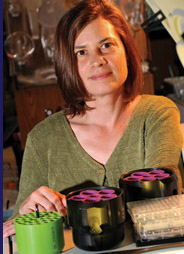Kathleen L. Collins, M.D., Ph.D.

- Title
- Professor
- Department
- Department of Internal Medicine
- Institution
- University of Michigan
- Address
-
Medical Science Research Building I Room 3510
1150 West Medical Center Drive - City, State, ZIP
- Ann Arbor, MI 48109
- Phone
- (734) 615-1320
- [email protected]
- Website
- https://collins.lab.medicine.umich.edu

- Research field
- Virology
- Award year
- 1999
Research
By mechanisms that are not well understood, HIV is able to evade the cytolytic T cell (CTL) arm of the immune system. Escape from the CTL response allows persistent infection and contributes significantly to disease progression. A clear understanding of the means by which the virus accomplishes this would allow the development of novel antiviral therapies. We have explored the possibility that HIV encodes a factor that protects infected cells from CTLs. To accomplish this, we developed a flow cytometric technique for detecting cell killing that was sensitive enough to detect the minority of living HIV-infected cells amongst a mixed population. This methodology employed an HIV molecular clone that encoded a marker protein (placental alkaline phosphatase, PLAP) in its genome. Infected cells were distinguished by the expression of PLAP on their surface. We used this assay to demonstrate that cells infected with an HIV-1 encoding a mutant nef gene were readily recognized and killed by anti-HIV CTL clones. However, HIV-infected cells expressing the nef gene were resistant to CTL-mediated lysis. A monoclonal antibody specific to MHC class I HLA-A2 revealed that expression of a functional nef gene resulted in a dramatic decrease in MHC class I HLA-A2 antigens on primary T cells. Those infected cells that had maximally downregulated MHC class I were most resistant to CTLs. The protective effect of nef could be reversed by exogenously adding an excess of specific peptide epitope. This demonstrated that protection was achieved via a reduced density of viral peptide epitope secondary to a reduction in MHC class I levels. Exogenous antigen reversed the effects of Nef by binding to residual MHC class I antigens on the cell surface and sensitizing the cell CTL killing. Thus we have learned that HIV Nef functions by reducing the density of MHC class I-epitope complexes on the infected cell surface and thereby protecting it from CTL recognition.
Future experimentation will focus on determining whether other viral factors influence CTL recognition, determining the structural elements of Nef important for MHC class I downmodulation.
Scholar Keywords
1999 Search Pew Scholars
- John D. Altman, Ph.D.
- Stephen C. Blacklow, M.D., Ph.D.
- Edwin R. Chapman, Ph.D.
- Kathleen L. Collins, M.D., Ph.D.
- Julia Promisel Cooper, Ph.D.
- James A. Goodrich, Ph.D.
- Mark W. Grinstaff, Ph.D.
- Bruce A. Hamilton, Ph.D.
- Rebecca W. Heald, Ph.D.
- Seung K. Kim, M.D., Ph.D.
- Makoto Kuro-O, M.D., Ph.D.
- Jeannie T. Lee, M.D., Ph.D.
- Roy M. Long, Ph.D.
- Kun Ping Lu, M.D., Ph.D.
- Matthew L. Meyerson, M.D., Ph.D.
- Dimitar B. Nikolov, Ph.D.
- Samuel L. Pfaff, Ph.D.
- John Sondek, Ph.D.
- Henrique P. von Gersdorff, Ph.D.
- Z. Hong Zhou, Ph.D.